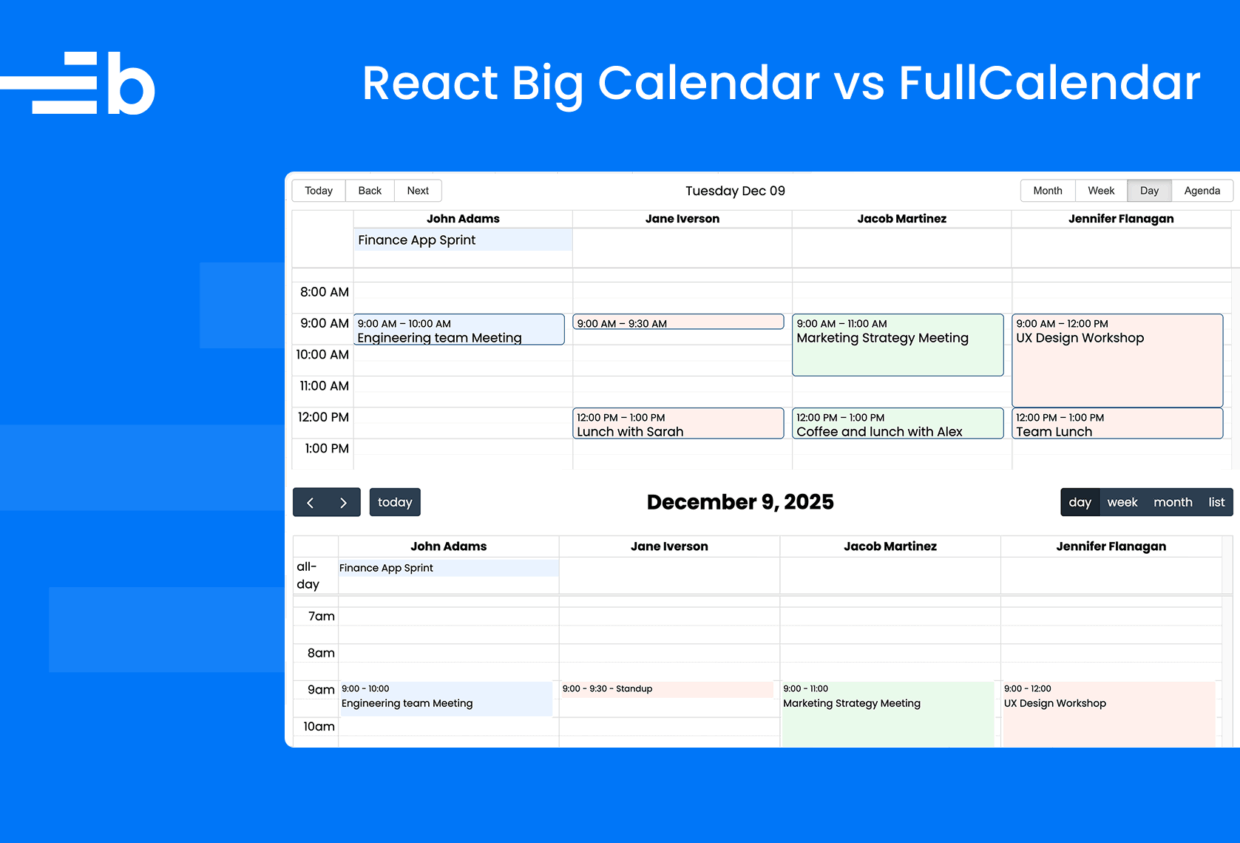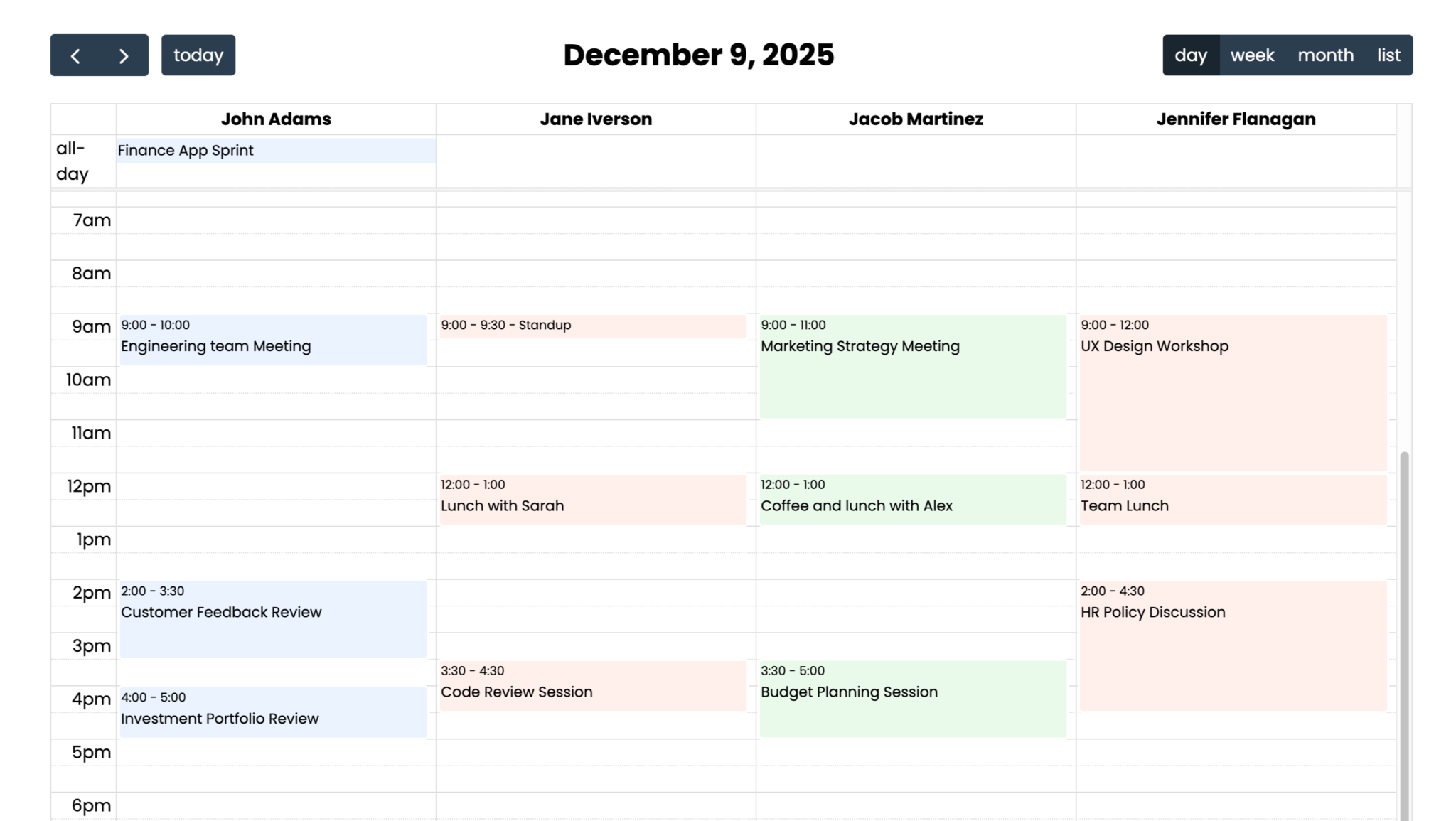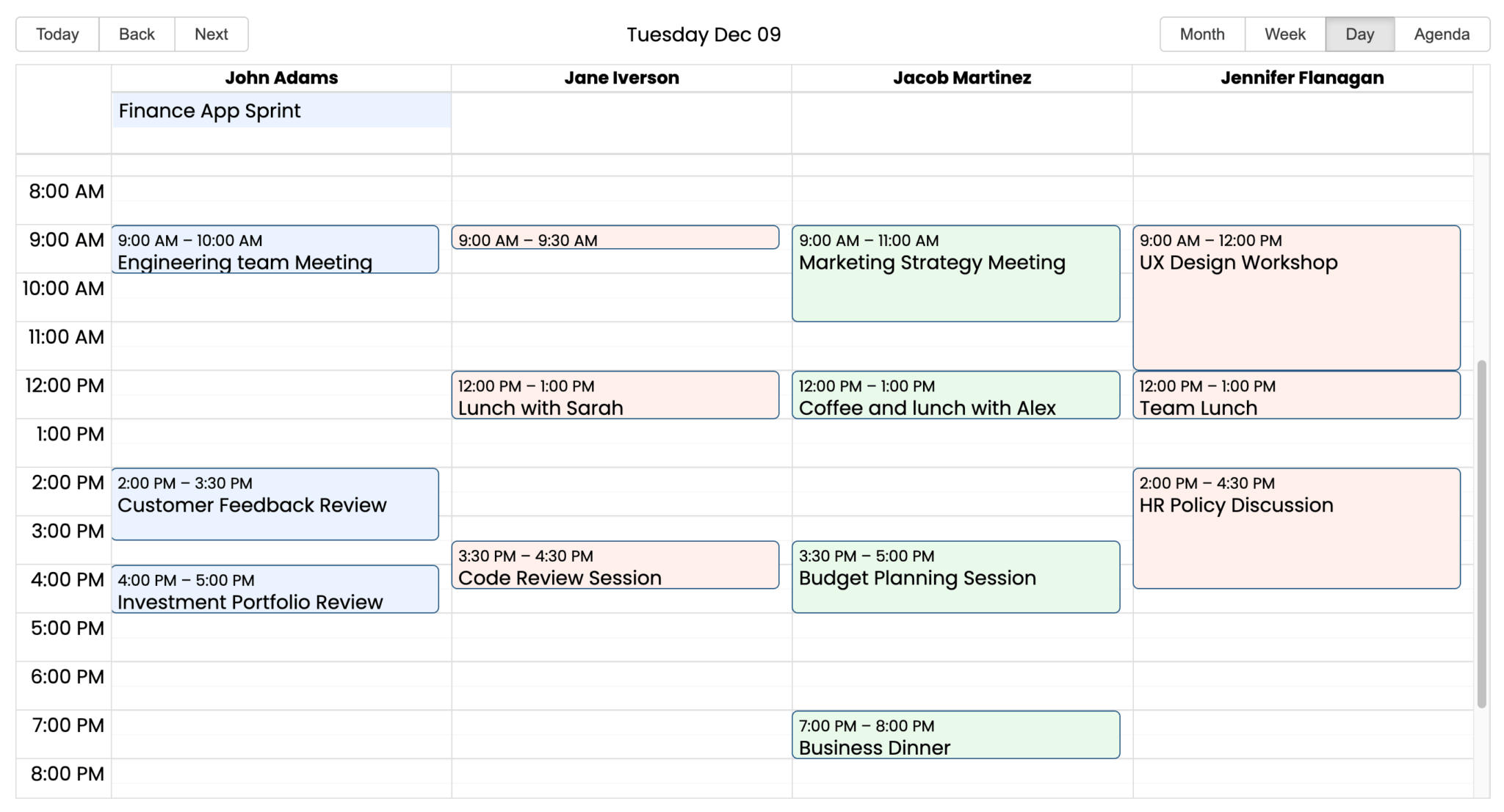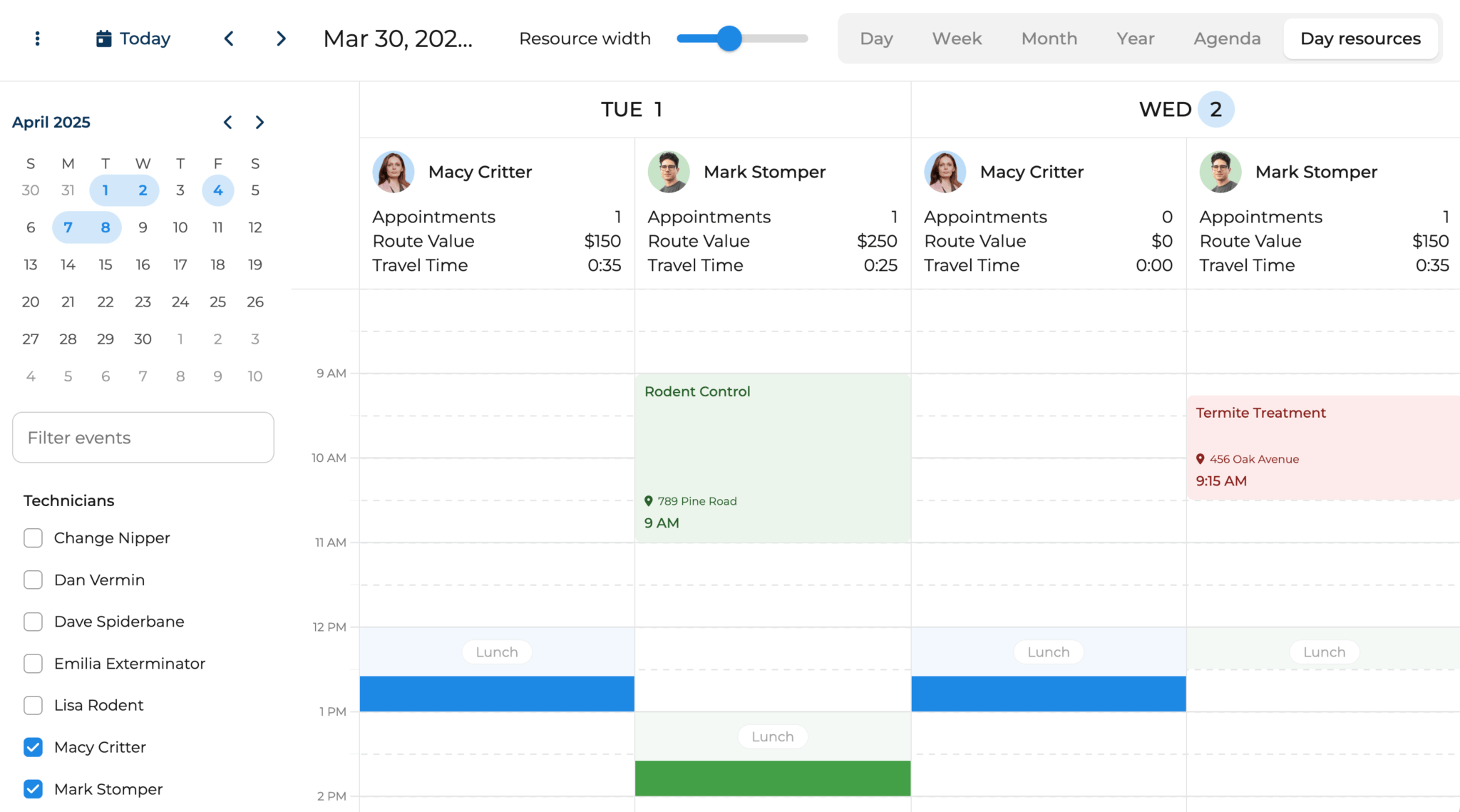React FullCalendar vs Big Calendar

React Big Calendar and FullCalendar are two popular React calendar components. When choosing a component for your app, should you go for the fully open-source React Big Calendar or the more widely used FullCalendar? This article explores the features, setup, and pricing of both calendars, and compares their pros and cons to help you choose the best component for your use case.
FullCalendar
FullCalendar is a JavaScript calendar built for React. It can also be used with vanilla JavaScript, TypeScript, Angular, and Vue, or as a web component. FullCalendar Standard is open source and has over 19,000 GitHub stars and over 1 million npm downloads per week. The commercial FullCalendar Premium offers additional features and support. You can browse examples of the available features on the FullCalendar Demos page.
Getting started
Use one of the following methods to add the FullCalendar library to your project:
- Initialize FullCalendar with script tags by downloading the FullCalendar library or using a CDN.
- Use npm.
FullCalendar’s functionality is split into plugins to reduce your project’s bundle size.
Install the core package, the React adapter, and any plugins you need:
npm install @fullcalendar/core @fullcalendar/react @fullcalendar/daygrid @fullcalendar/timegrid @fullcalendar/list @fullcalendar/interaction @fullcalendar/resource-timegrid @fullcalendar/resource-timelineThe @fullcalendar/react package is the React adapter for FullCalendar, which is a React component that wraps the FullCalendar API.
Premium plugins require a license, but you can try them out using the unlimited free trial.
The <FullCalendar> component accepts any of the FullCalendar configuration options as props.
import FullCalendar from '@fullcalendar/react';
import resourceTimelinePlugin from '@fullcalendar/resource-timeline';
import dayGridPlugin from '@fullcalendar/daygrid';
import resourceTimeGridPlugin from '@fullcalendar/resource-timegrid';
import listPlugin from '@fullcalendar/list';
import interactionPlugin from '@fullcalendar/interaction';
const calendarEl = document.getElementById('root');
if (!calendarEl) {
throw new Error('Calendar element with ID "app" not found');
}
export default function Calendar() {
return (
<FullCalendar
initialDate='2025-12-08'
plugins={[resourceTimelinePlugin, dayGridPlugin, resourceTimeGridPlugin, listPlugin, interactionPlugin]}
initialView='resourceTimeGridDay'
editable={true}
headerToolbar={{
left: 'prev,next today',
center: 'title',
right: 'resourceTimeGridDay,timeGridWeek,dayGridMonth,listWeek'
}}
resources={[
{
id: 'a',
title: 'John Adams',
eventBackgroundColor: '#eaf3ff',
}
]}
events={[
{
id: '1',
title: 'Client Meeting',
start: '2025-12-08T10:00:00',
end: '2025-12-08T11:00:00',
resourceId: 'a'
}
]}
eventTextColor='black'
eventBorderColor='white'
/>
);
}You need to add at least one calendar view plugin as a prop, such as the resourceTimeGridPlugin, which lets you display resources as columns.
The headerToolbar property defines the buttons and the title at the top of the calendar. There are two types of data: resources and events. There are different event data sources that you can use. Data can be passed in as an array, a URL that provides the data as a JSON object, or a function. Resource data can be obtained the same way. Events can also be retrieved from Google Calendar or an iCalendar feed.
To sync changes to a backend, you can make use of the available event callbacks such as eventChange, resourceChange, eventDrop, and eventResize.
The calendar has a themeSystem for styling. By default, it uses the minimalist 'standard' theme. Bootstrap themes are also available.

Features
FullCalendar’s extensive API has over 300 settings. Its Standard features include:
- Drag and drop events
- Selectable dates
- Background events
- Theming
- Locales
- Time zone support
- Accessibility (keyboard navigation and screen reader support)
The Premium features include:
View the full list of features in the FullCalendar docs.
Pricing
The core features are open source and free. A license is required to access the FullCalendar Premium features. Pricing starts at $480 per developer. The license is valid for one year and includes upgrades, full source-code access, and email support. If you renew your license before it expires, you get a 50% discount. If you renew after your license has expired, you get a 25% discount.
Pros
The advantages of using FullCalendar include:
- Popularity and community support: With over 1 million npm downloads per week, over 19,000 GitHub stars, and over 9,000 questions on Stack Overflow, you are likely to find solutions to common issues.
- Framework flexibility: FullCalendar supports all major JavaScript frameworks (React, Vue, and Angular), so you can switch between frameworks more easily, if needed.
- The extensive feature set: The library includes essential calendar functionality like drag-and-drop events, date selection, and time zone handling.
- An unlimited Premium trial: You can test out the Premium features without time constraints, helping you make informed decisions before purchasing.
- Modular architecture: The plugin-based system keeps bundle sizes minimal by only including needed functionality.
- Extensive documentation and examples: The official FullCalendar Example Projects repository provides simple demo projects that show you how to use FullCalendar with different build setups.
Cons
Despite its popularity, FullCalendar has several limitations, including:
- Limited functionality: The library lacks commonly used calendar features, such as exporting to Excel and ICS formats, and there is no event editor or event creation dialog. You need to build your own forms and modals for event editing and creation.
- Performance issues with large datasets: There is an unresolved performance issue in the FullCalendar GitHub repo where loading 5000 resources and their events caused the calendar UI to become unresponsive and laggy. This is due to the lack of virtual rendering, which improves performance by only rendering the visible events and resources.
- Basic styling and theming: The default UI looks dated and requires additional CSS styling to achieve a modern, polished look.
- Steep Premium pricing: The Premium pricing is expensive, considering it only gives you three more features and email support with two tickets per month.
React Big Calendar
React Big Calendar is an entirely free, open-source, React-only calendar component inspired by FullCalendar. The library has over 8,500 GitHub stars and close to half a million npm downloads per week. You can browse examples of React Big Calendar features in the Big Calendar Docs.
Getting started
Install React Big Calendar using npm:
npm install react-big-calendarThe <Calendar> component accepts configuration options as props:
import { useState, useCallback } from 'react';
import { Calendar, Views, dateFnsLocalizer } from 'react-big-calendar';
import withDragAndDrop, { type withDragAndDropProps } from 'react-big-calendar/lib/addons/dragAndDrop';
import { format } from 'date-fns/format';
import { parse } from 'date-fns/parse';
import { startOfWeek } from 'date-fns/startOfWeek';
import { getDay } from 'date-fns/getDay';
import { enUS } from 'date-fns/locale/en-US';
import 'react-big-calendar/lib/addons/dragAndDrop/styles.css';
import 'react-big-calendar/lib/css/react-big-calendar.css';
const DragAndDropCalendar = withDragAndDrop(Calendar);
const locales = {
'en-US': enUS,
};
const localizer = dateFnsLocalizer({
format,
parse,
startOfWeek,
getDay,
locales,
});
const bigCalendarResources = [
{
resourceId: 'a',
resourceTitle: 'John Adams',
eventBackgroundColor: '#eaf3ff',
}
];
const bigCalendarEvents = [
{
id: '1',
title: 'Client Meeting',
start: new Date(2025, 11, 8, 10, 0, 0),
end: new Date(2025, 11, 8, 11, 0, 0),
resourceId: ['a']
}
];
export default function DnDResource() {
const [myEvents, setMyEvents] = useState(bigCalendarEvents);
const moveEvent = useCallback(
({
event,
start,
end,
resourceId,
isAllDay: droppedOnAllDaySlot = false,
}) => {
const { allDay } = event;
if (!allDay && droppedOnAllDaySlot) {
event.allDay = true;
}
setMyEvents((prev) => {
const existing = prev.find((ev) => ev.id === event.id) ?? {};
const filtered = prev.filter((ev) => ev.id !== event.id);
return [...filtered, { ...existing, start, end, resourceId, allDay }];
});
},
[setMyEvents]
);
const resizeEvent = useCallback(
(data: withDragAndDropProps['onEventResize']) => {
const { event, start, end } = data;
setMyEvents((prev) => {
const existing = prev.find((ev) => ev.id === event.id) ?? {};
const filtered = prev.filter((ev) => ev.id !== event.id);
return [...filtered, { ...existing, start, end }];
});
},
[setMyEvents]
);
return (
<DragAndDropCalendar
defaultDate={new Date(2025, 11, 9)}
defaultView={Views.DAY}
events={myEvents}
localizer={localizer}
onEventDrop={moveEvent}
onEventResize={resizeEvent}
resizable
resourceIdAccessor="resourceId"
resources={bigCalendarResources}
resourceTitleAccessor="resourceTitle"
selectable
showMultiDayTimes={true}
step={30}
eventPropGetter={(event) => {
let backgroundColor = 'blue';
console.log(event.resourceId);
if (event.resourceId[0] === 'a') {
backgroundColor = '#eaf3ff';
}
if (event.resourceId[0] === 'b') {
backgroundColor = '#fff1ec';
}
if (event.resourceId[0] === 'c') {
backgroundColor = '#e9faeb';
}
if (event.resourceId[0] === 'd') {
backgroundColor = '#fff1ec';
}
return {
style: {
backgroundColor,
color: 'black'
}
};
}}
/>
);
}To render the calendar, you must choose a localizer, which is an adaptor that handles date internationalization and localization.
The drag-and-drop feature requires an addon and manual setup. You need to handle event movement and resizing logic yourself, unlike for FullCalendar, which provides this functionality out of the box.
For date handling and localization, you need a third-party library such as date-fns:
npm install date-fnsWhen you include React Big Calendar in your app, you need to include the core styles. The library provides a precompiled stylesheet (react-big-calendar/lib/css/react-big-calendar.css). To customize the styles, you can change the color and sizing variables in the SASS files.

Features
The React Big Calendar features include:
- Multiple calendar views (Month, Week, Work Week, Day, and Agenda)
- Drag-and-drop events (requires manual setup)
- Event selection and navigation
- Resource view support
- Custom views
- Locales
- Time zone support
- Background events
Pricing
React Big Calendar is completely free and open source under the MIT license. It has no premium features and requires no licenses or subscription costs. All features are available for use without restrictions in both commercial and non-commercial projects.
Pros
The advantages of using React Big Calendar include:
- Completely open-source code: There are no licensing costs, premium features, or subscription fees.
- The free resource view: Unlike in FullCalendar, where the resource view is a premium feature.
- Popularity and community support: Although it’s not as popular as FullCalendar, React Big Calendar has a large community of developers.
- Access to starter projects: There are three starter projects available.
Cons
React Big Calendar has several disadvantages:
- Poor documentation and searchability: The documentation is only available as a Storybook site with limited search functionality. You can only search for components and props, and cannot easily search for specific text in the documentation.
- Missing basic features: It has no built-in event editor, event creation dialogs, or drag-and-drop feature, all of which are essential for most professional calendar applications. This means a lot of manual implementation is required. React Big Calendar doesn’t provide any data change events either.
- Limited styling and theming options: The library offers basic styling with one default theme. The custom styling approach requires manual SASS variable modifications, and even simple tasks, like changing event background colors, require custom logic. You need to use the
eventPropGetterinstead of adding a simple property. - Framework lock-in: React Big Calendar only supports React, which can be problematic if you need to switch frameworks.
- Outdated community resources: Many starter projects and demos are outdated and unmaintained, including popular repositories like rbc-starter and rbc-with-dnd-starter.
Choosing between FullCalendar and React Big Calendar
When you compare the two libraries’ features, it’s clear that FullCalendar is the best choice in almost every scenario. The only reason to choose React Big Calendar is if you need to use resource views for free.
| FullCalendar | React Big Calendar | |
|---|---|---|
| Easy to customize | ✔️ | ❌ |
| Advanced features | ❌ | ❌ |
| Data fetching helpers | ✔️ | ❌ |
| Handle large datasets | ❌ | ❌ |
| Styling themes | ✔️ | ❌ |
| Open source | ✔️ | ✔️ |
| Accessibility | ✔️ | ❌ |
| React, Angular, and Vue support | ✔️ | ❌ |
| TypeScript support | ✔️ | ✔️ |
| Time zone support | ✔️ | ✔️ |
| Custom rendering | ✔️ | ✔️ |
| Export to Excel | ❌ | ❌ |
| Export to ICS format | ❌ | ❌ |
| Formatting for printing | ✔️ | ❌ |
| Module splitting | ✔️ | ❌ |
| Resource views | ✔️ * | ✔️ |
* Only for the Premium license.
While React Big Calendar is completely free, its hidden cost lies in development time. React Big Calendar requires extensive manual implementation for basic functionality, like drag-and-drop and data change events. Even simple tasks, such as changing event colors, require custom logic.
FullCalendar’s out-of-the-box features, extensive documentation and API, community support, and cross-framework compatibility make for a better development experience.
Bryntum Calendar
If neither FullCalendar nor React Big Calendar meets your needs, consider using Bryntum Calendar, a React UI component that offers enterprise-grade calendar functionality with comprehensive features out of the box. Bryntum Calendar readily supports Vue, Angular, and other frameworks and smoothly integrates with modern web development tools.

Bryntum Calendar includes all essential features such as drag-and-drop, a built-in event editor, resource views, and exports to Excel, ICS, and optimized print formats.
The component also provides advanced enterprise features that neither FullCalendar nor React Big Calendar offer:
- Travel time visualization for real-world scheduling and planning
- Workload tracking with the capacity tick renderer to prevent resource overallocation
- Seamless switching between related resource calendars for complex scheduling scenarios
- Undo and redo functionality for confident user interactions
- Exceptional performance with massive datasets through virtual rendering
- A CRUD Manager for streamlined data synchronization and backend integration
Bryntum products come with a set of UI widgets, including buttons, date pickers, toasts, modals, and dropdown menus, which you can use to achieve a consistent design across your application.
While Bryntum Calendar requires a commercial license, it significantly reduces development time by providing professional-grade features that could take months to implement yourself. You can sign up for a free 45-day trial to test whether Bryntum Calendar is the right fit for you. Bryntum offers a discount for startups, charities, environmental organizations, and educational use cases, or when you describe how you use our products on your company’s website.

Visit the demos page to explore the full range of features, customizations, integrations, and beautiful themes available.